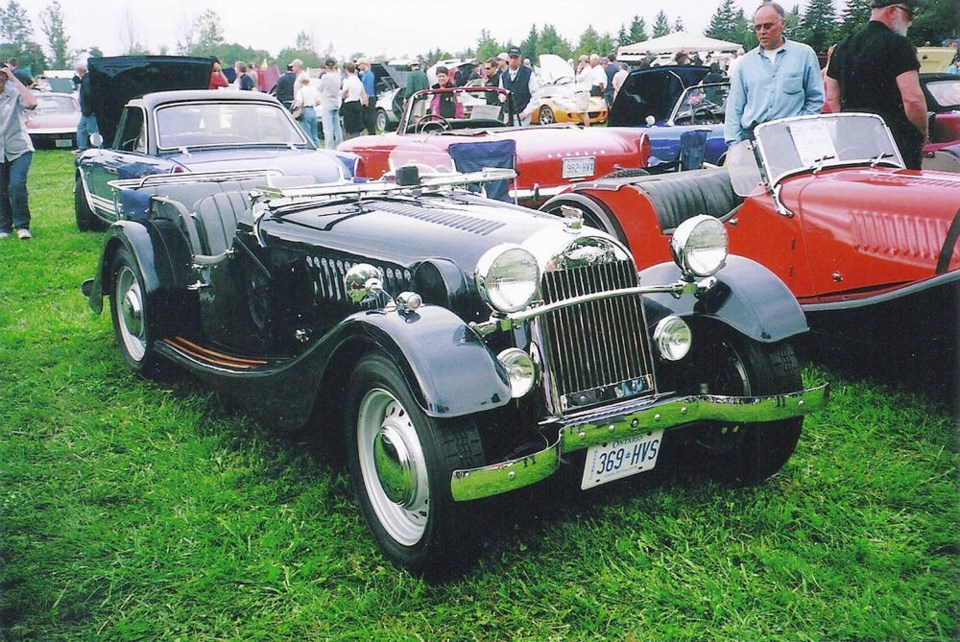Henry Frederick Stanley Morgan was born in 1884, the son of a vicar. But HFS didn’t follow his father’s calling, he chose engineering. After London’s Crystal Palace Engineering College, he began an engineering apprenticeship with Great Western Railway.
But HFS became more interested in the increasingly popular cars than in trains and in 1906 he and a partner opened a garage and automobile dealership in Malvern, Worcestershire. Another followed, and the prosperity brought HFS dreams of building his own car.
HFS owned a three-wheeled Eagle which probably influenced him to create a three-wheeler. He welded up a light, sturdy, steel-tube chassis and mounted a Peugeot air cooled V-twin engine between the front wheels. The driveshaft passed through the central frame member and drove the single rear wheel via two chains.
Steering was by tiller and the independent front suspension was a rarity. It was an ingenious sliding-pillar-and-coil-spring arrangement HFS adapted from a French Decauville design. It proved simple, effective and durable. The “body” was basic, a single seat, hood and front fenders.
Morgan displayed two cars at London’s 1910 Olympia motor cycle show and despite the single seat a few were ordered. The show made Morgan realize he needed two things: two passenger accommodation and a successful competition record.
When HFS couldn’t find someone to produce his cars he decided to form his own business, and established the Morgan Motor Co. in 1910.
He entered the London to Exeter trial on Boxing Day, 1910, winning the gold medal. Thanks to Morgan’s high power-to-weight, many competition successes followed. At the 1911 show his two-seater prototype attracted many orders.
The company prospered and a few years later moved to the adjoining red brick buildings the company still occupies in the town of Malvern Link. With a variety of three-wheelers, including competition and four-seater family models, power came from such air and water cooled engines as Anzani, JAP, Blackburn and Ford.
Although three-wheelers were taxed at about half that of four-wheelers like Austin Sevens and Morris Minors, by the 1930s HFS realized the future lay with four wheels. In 1936, a four-wheel Morgan 4-4 (four wheels, four cylinders), was added in two-and four-passenger forms. Three-wheelers continued in dwindling numbers until the early 1950s.
North America was introduced to the Morgan 4/4 following the Second World War in about 1948 (with the 4/4, for some reason, with a slash [/] instead of a dash [-]), and beginning in 1951, the Plus 4 with a 2.1 litre Standard Vanguard engine. As with three-wheelers, Morgan four-wheelers used a variety of power including Ford, Standard and Triumph.
A flirtation with modern styling brought the Morgan Plus 4 Plus in 1964, an aerodynamic, fibreglass bodied coupe. It was poorly received by Morgan enthusiasts and was discontinued in three years after 50 were built.
To keep Morgan performance contemporary, Morgan introduced a new 1968 Plus 8 with the Rover (previously General Motors) 3.5 litre, overhead valve aluminum V-8. Road & Track recorded zero to 60 mph (97 km/h) in 8.5 seconds and top speed of 105 mph (169 km/h), very respectable considering the primitive aerodynamics.
Morgan family involvement continued for many years. HFS’s son Peter became chairman of the board in 1958, and HFS died in 1959. Peter died in 2003 and his son Charles became managing director until the company removed him from the position in 2013.
Traditionally styled Morgans are still built by artisans skilled in wood, steel and fabric, much as they always have. Aluminum or steel parts are fitted over hand-built oak body-frames.
A more modern Aero 8 Morgan powered by BMW’s 4.4 litre V-8 was built from 2001 to 2010, its first new model since the 1968 Plus 8. Styled by Charles Morgan, it blended traditional Morgan styling with modern aerodynamics.
Although continued on other models, on the Aero 8 the sliding pillar front suspension was replaced by modern control arms and coil springs. There was also independent rear suspension.
Morgan’s traditional high power-to-weight ratio gave outstanding performance. Car and Driver reported a blistering 4.2 second zero to 60 mph (97 km/h) and 155 mph (250 km/h) top speed. The Aero 8 was sold in the U.S. It was approval by the U.S. National Highway Traffic Safety Administration but not by Transport Canada. Traditional Morgans including the 4/4 are still being built and are also banned.
Morgan production is still a cottage industry; there are no assembly lines at Malvern Link. Until spray painting was inaugurated in the 1960s Harold Jauncey painted every Morgan by hand — with a brush!
Brush painting, clamshell fenders, ash body-frames, sliding pillar suspension — change comes slowly at Morgan. But Morganistis love it that way, and willingly wait several months to get a new one (except in Canada).



